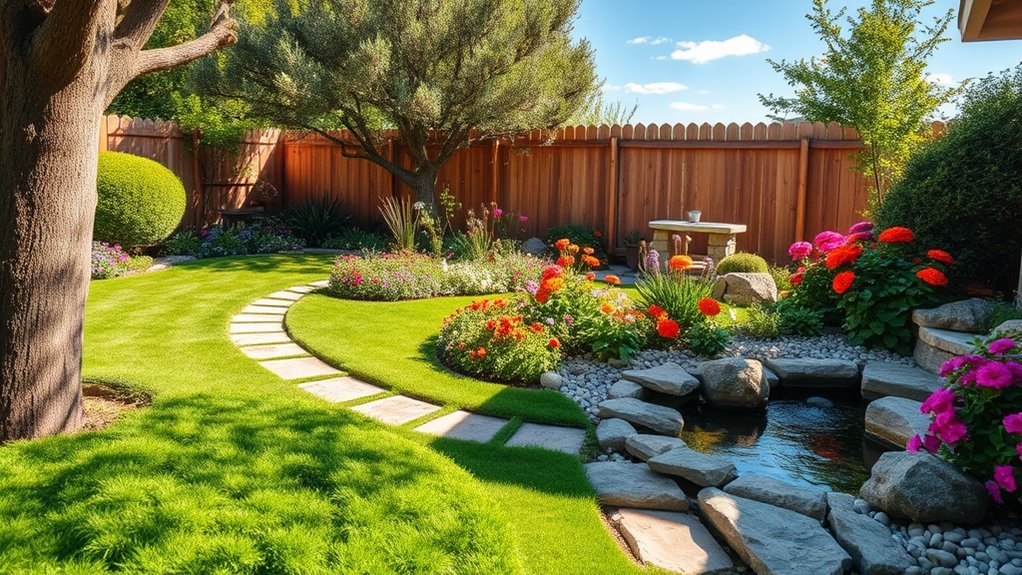Hey, wanna turn your backyard into a cool hangout spot? First, check out garden styles online or at local parks for fresh ideas. Next, focus on big features, like trees or patios, to set the vibe. Then, match plants to your home? s look for a seamless feel. Don? t forget to study sunlight and water spots before planting. Finally, plan for growth so things don? t get cramped. Stick around to uncover more tips!
Key Takeaways
- Explore garden styles like modern or cottage for unique home inspiration.
- Identify focal points like trees or patios to anchor your design.
- Match plants to your home? s style for a cohesive look.
- Assess sunlight and drainage to select suitable plant locations.
- Plan for plant growth to avoid future overcrowding issues.
Discover Inspiring Garden Designs
As you start planning your home garden, let? s plunge into finding some cool inspiration.
Check out different garden styles, like modern or cottage, to match your taste and local weather. Visit botanical gardens nearby, and see how plants blend in real landscapes. Isn? t it neat to spot ideas you can use?
Browse tons of garden photos online, with bright flowers or fun containers, to spark your creativity. Keep up with 2025 gardening trends, too, for fresh, eco-friendly ideas.
Look for yard designs that work well and look good. And hey, don? t forget your basic tools? shovels and trowels? to start bringing those ideas to life. Consider incorporating vegetable garden layouts to combine functionality with aesthetic appeal in your outdoor space.
What style grabs you most? Think of your garden as a blank canvas, ready for your touch!
Explore stunning garden pathway ideas to elevate your landscape with elegance and charm.
Focus on Major Landscape Features First
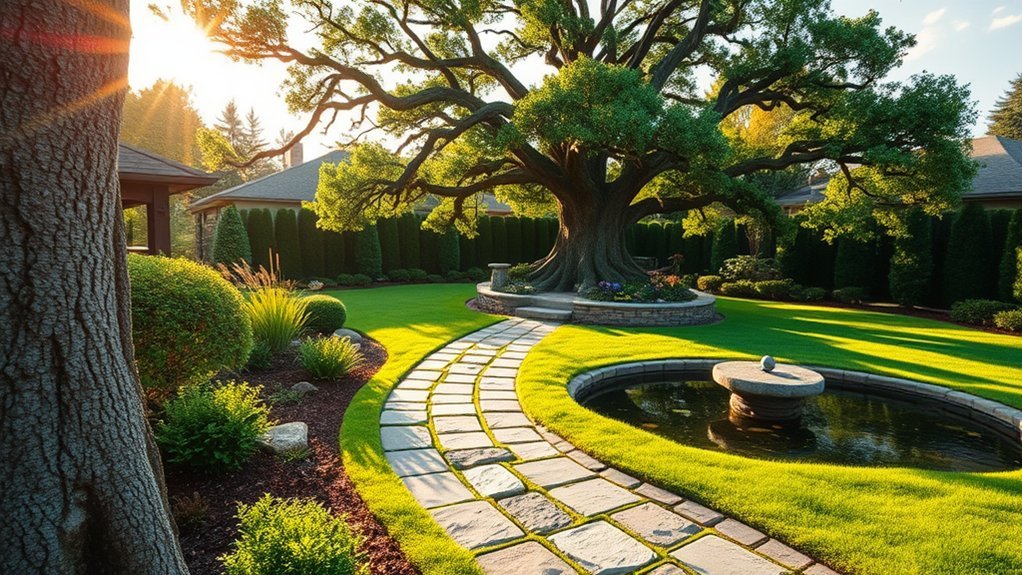
Hey there, let? s dive right into shaping your garden by focusing on the big stuff first. Start by spotting major focal points, like mature trees or big shrubs, to anchor your design. Then, think about adding solid structures, say ponds or patios, early on for a clear layout. This efficient use of planning keeps everything cohesive, so arrange other plants to highlight these key spots.
Wondering what to prioritize? Check this table for ideas:
| Feature Type | Example | Placement Tip |
|---|---|---|
| Natural Element | Mature Tree | Center or corner spot |
| Hardscape | Patio | Near seating areas |
| Water Feature | Pond | Visible from main paths |
| Structure | Archway | Entry or connection point |
Prioritize these before smaller plants, ensuring they stand out. How? ll you start?
Blend Your Home With the Landscape
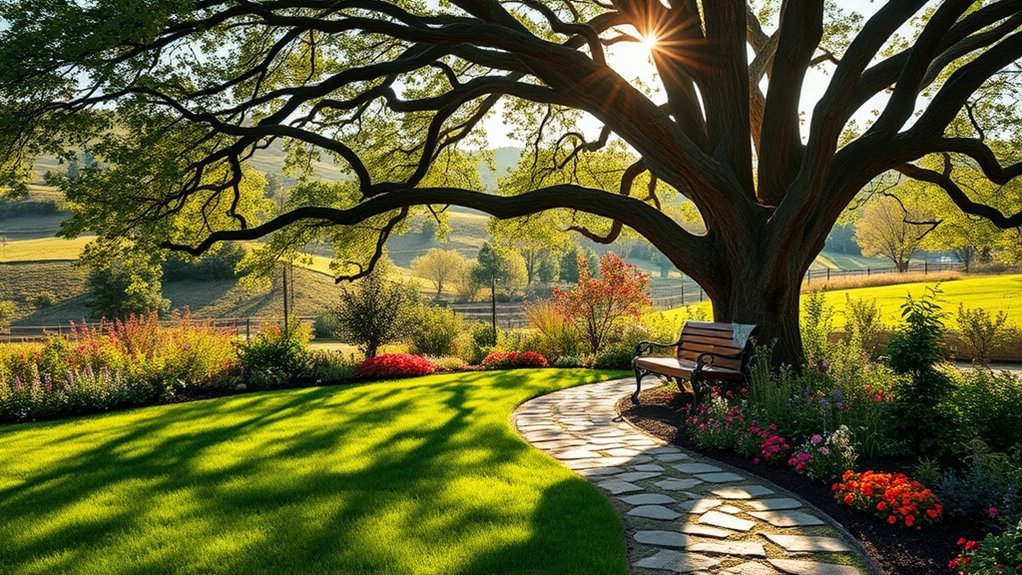
While you’re shaping your garden, let’s think about blending it with your home’s look.
Pick plants that match your house’s style and colors, so they frame it nicely. Position big trees and shrubs to balance things out, making sure they don’t hide your home’s best features.
Choose plants that complement your home? s style and hues, framing it beautifully. Arrange trees and shrubs to enhance, not obscure, its charm.
Got a favorite spot? Use evergreens to keep it pretty all year. Designing a space with accessible pathways ensures everyone can enjoy the garden comfortably.
Try pathways and lighting to draw eyes to your door, making it welcoming. Also, connect patios or decks with garden beds using similar stuff, like matching stones or plants.
It? s like tying two friends together! How can you mix these ideas?
Consider adding family-friendly elements like a small play area for kids to enjoy safely in the garden.
Analyze Light and Water Conditions
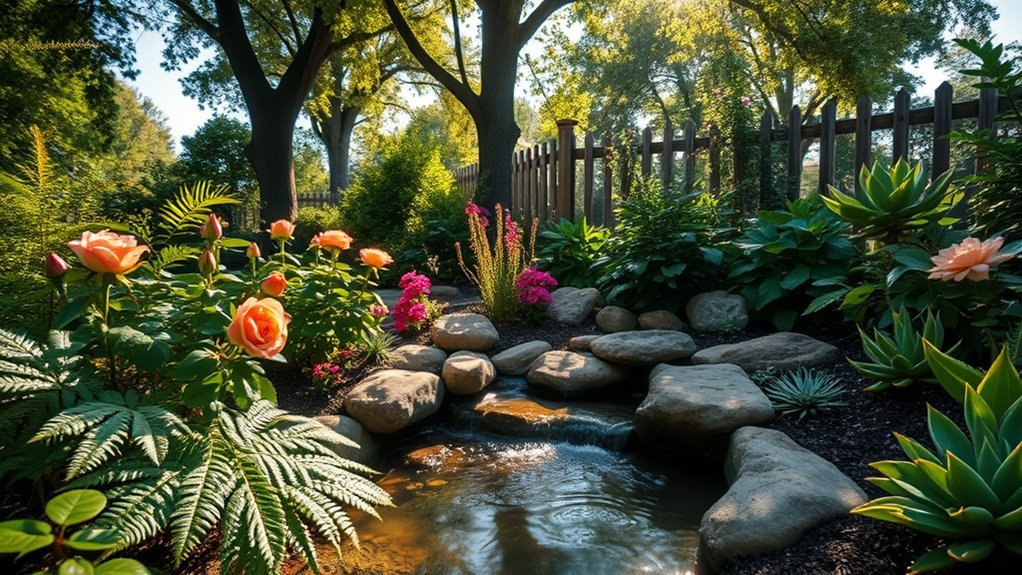
Let’s shift gears a bit and talk about figuring out your garden’s light and water setup.
First, check how sunlight hits your yard throughout the day. Watch at different times to spot full sun, partial shade, or full shade areas. Where? s the best spot for your plants?
Next, look at water patterns after rain. Do you see pooling or super dry spots? This helps you pick the right plants, like shade-lovers for dim areas or succulents for sunny, dry zones.
Also, match plants to your local hardiness zone for better results. Got a wet spot? Turn it into a rain garden!
Even subsidiaries and affiliates of big garden brands stress knowing these basics for success.
What? s your garden telling you?
Plan for Long-Term Growth
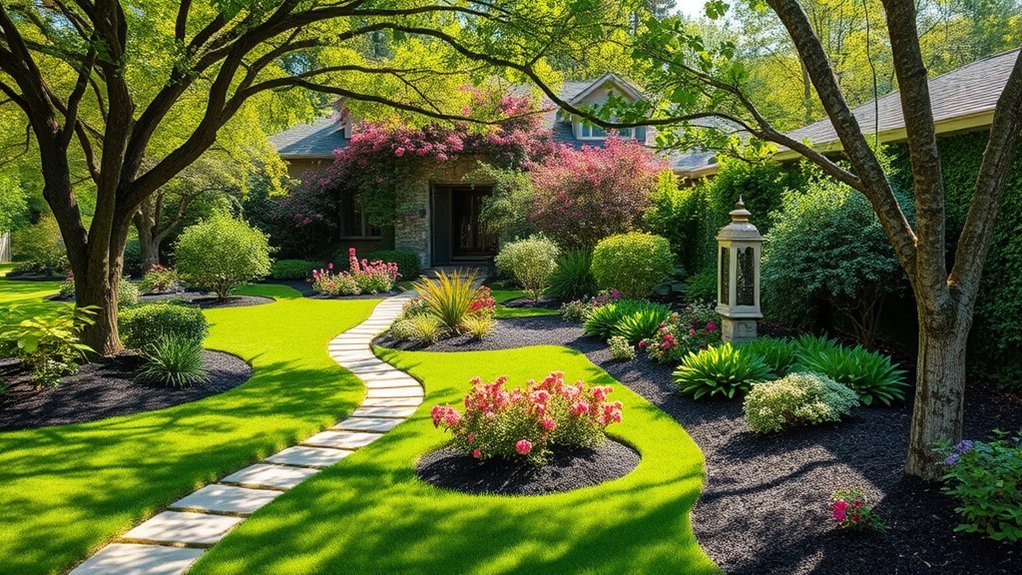
As you plunge into planning your garden, think about how big those plants will get. You don? t want overcrowding, right?
Consider growth projections to avoid trees or shrubs squeezing too close to your house or utilities. Research each plant? s mature size and growth rate, and plan spacing with sunlight changes in mind.
Here? s how to keep it simple and smart:
- Check mature sizes – Know how tall and wide plants will grow.
- Think about shade – Will a big tree block your sun later?
- Pick native plants – They adapt better, saving you work long-term.
- Space wisely – Give roots room to spread without issues.
Planning now saves headaches later. Got a favorite plant? Double-check its future size! For inspiration, explore creative garden ideas to see how others plan for sustainable growth. Additionally, incorporating unique decor can elevate your garden? s appeal with innovative design elements that transform your outdoor space.
Frequently Asked Questions
What Is the Rule of 3 in Landscaping?
Hey, you? ve gotta know the Rule of 3 in landscaping! Group plants or elements in threes to create visual balance. It? s dynamic, natural, and draws the eye, so don? t skip this awesome trick!
What Are the 5 Basic Elements of Landscaping?
Hey, when planning your Garden Design, you’ve gotta know the five basic elements of landscaping. Focus on plants, soil, water, hardscaping, and lighting. They’re essential, so don’t skip any for a stunning result!
What Are the 8 Basic Principles of Landscape Design?
Hey, you’re diving into the 8 basic principles of landscape design! Master balance, contrast, changeover, proportion, repetition, focalization, unity, and rhythm. Don’t forget, incorporating sustainable practices guarantees your design’s eco-friendly and long-lasting impact.
What Is the First Rule of Landscaping?
Picture a serene, cohesive yard where everything flows together. You? ve gotta grasp the first rule of landscaping: create a balanced look using Design Fundamentals. Unite variety and harmony to craft a stunning space.
Conclusion
Hey, you? ve got the basics to transform your garden now, right? Think of your yard as a blank canvas, waiting for your masterpiece. Start with these five tips, and don? t rush it. Focus on big features, blend your home, check light and water, and plan ahead. How will you shape your space? Keep it simple, yet smart, and watch it grow. Got a favorite idea to try first?

